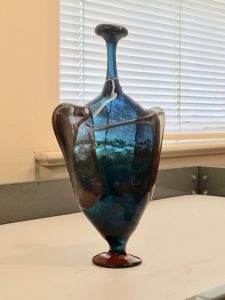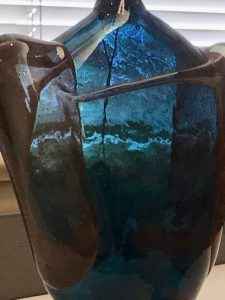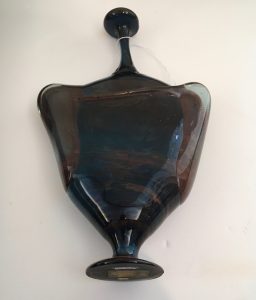“One of my favorite, unique properties of glass is the constant change in viscosity due to variations of temperature. I love the arrested viscous flow of cooling glass, as I strive for a balance between control and spontaneity. Viscous movement is exactly what I want all my work to demonstrate.” So writes Fritz Dreisbach, the creator of “Non-Bottle,” one of the pieces we viewed in the Ackland study room. If Dreisbach is concerned with sculpting glass objects that are between stasis and flow, between spontaneity and control, then “Non-Bottle” is a full manifestation of these tensions. The piece, standing about a foot tall, emphasizes its liquid qualities; it almost appears to be made of ice that is in the process of melting. Dreisbach accomplishes this sense through many aspects of the piece’s design: the shape of  the container, with its tapered top and pooled wideness in the middle of its body, suggests a downward, melting motion; the glass’ texture is smooth to the point where it looks wet or glistening, which also heightens the sense that the piece is a frozen moment of a viscous liquid’s motion downwards; the blue hue of the glass in the center has an aquatic or deep-sea quality, as well. After some research into how glass is colored, I realized that copper and iron compounds were likely used to give the glass both its deep blue and rusty brown colors, which is reminiscent of the relationship between water and dry land.
the container, with its tapered top and pooled wideness in the middle of its body, suggests a downward, melting motion; the glass’ texture is smooth to the point where it looks wet or glistening, which also heightens the sense that the piece is a frozen moment of a viscous liquid’s motion downwards; the blue hue of the glass in the center has an aquatic or deep-sea quality, as well. After some research into how glass is colored, I realized that copper and iron compounds were likely used to give the glass both its deep blue and rusty brown colors, which is reminiscent of the relationship between water and dry land.
 There is tension evident in the piece’s structure, too. When not viewed with light shining through it – such as when it is laid on a table, rather than stood upright – the piece appears to be made from a single piece of glass. However, when light is shone through the piece, it is evident that is made of several separate pieces of glass that were melded onto the central body. One of the most interesting aspects of this structure are the wings on either side of the body, which are solid (as contrasted with the hollow center) and uncolored. The thickness of the wings lends the piece a sense of sturdiness, whereas its fragility is emphasized with the hollow body and delicate spout and base. The wings also lead the viewer to try to understand the piece as comprised of separate parts. After a closer look, it becomes apparent that the central body is a blown, hollow piece of glass; the base is part of this same piece, and must have been formed by pressing a blunt face against it after the body was blown, but while the glass was still hot. The wings are two separate, solid pieces attached to the body/base piece; the places where their edges meet the body have been smoothed, and preserve the continuity of the central body’s curves. The fourth and final piece is the spout, which is a solid, knob-like form that has been melded into the central body.
There is tension evident in the piece’s structure, too. When not viewed with light shining through it – such as when it is laid on a table, rather than stood upright – the piece appears to be made from a single piece of glass. However, when light is shone through the piece, it is evident that is made of several separate pieces of glass that were melded onto the central body. One of the most interesting aspects of this structure are the wings on either side of the body, which are solid (as contrasted with the hollow center) and uncolored. The thickness of the wings lends the piece a sense of sturdiness, whereas its fragility is emphasized with the hollow body and delicate spout and base. The wings also lead the viewer to try to understand the piece as comprised of separate parts. After a closer look, it becomes apparent that the central body is a blown, hollow piece of glass; the base is part of this same piece, and must have been formed by pressing a blunt face against it after the body was blown, but while the glass was still hot. The wings are two separate, solid pieces attached to the body/base piece; the places where their edges meet the body have been smoothed, and preserve the continuity of the central body’s curves. The fourth and final piece is the spout, which is a solid, knob-like form that has been melded into the central body.
 That the spout is solid and fully-enclosing is the element that gives the piece its title; as the spout seals the otherwise hollow central body, the functionality of the piece as a bottle is lost, and it therefore becomes a “non-bottle.” This is perhaps the piece’s overarching tension: it mimics a container or a flask-like object, but because its interior space is inaccessible, the piece cannot hold anything other than the blown air that was used to create it. It is, therefore, a bottle in every regard except for that which makes a bottle a bottle: its usability as a container of liquid. Instead, in “Non-Bottle,” the liquid is the piece itself, rather than what is contained within it.
That the spout is solid and fully-enclosing is the element that gives the piece its title; as the spout seals the otherwise hollow central body, the functionality of the piece as a bottle is lost, and it therefore becomes a “non-bottle.” This is perhaps the piece’s overarching tension: it mimics a container or a flask-like object, but because its interior space is inaccessible, the piece cannot hold anything other than the blown air that was used to create it. It is, therefore, a bottle in every regard except for that which makes a bottle a bottle: its usability as a container of liquid. Instead, in “Non-Bottle,” the liquid is the piece itself, rather than what is contained within it.